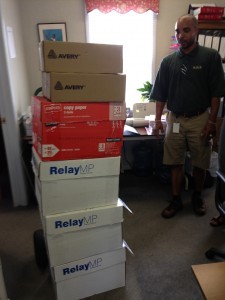Legal Nurse Consultants: How to Estimate a Length of a Project
This is a pretty broad question and it is hard to give a precise answer. As a legal nurse consultant, I got asked this question by some of our clients when they sent me a set of medical records. Sometimes they asked the question before the records came. Here are some questions for you to ask in order to answer the attorney’s question.
- Are you planning to send paper record or electronic files?
- How big are the records?
- Are they copied on one side or two sides?
- What do you want me to do with the records?
- Do you have a budget for my work?
Many of us have distinct preferences for paper records or for electronic (PDF) files. Some LNCs love to organize paper and put it in indexed binders. Others love to open up PDFs on their computers and scan through medical records.
I am a paper lover. I found it hard to read page after page on a monitor and even harder to analyze information if the record was scanned in a random order.
If you are a paper lover and have to review the material on a monitor, your review time will likely increase. It may be much more efficient for you to organize and tab paper records than to try to do so on a monitor. You can suggest that the attorney can reduce some of the hours you would have to spend by printing out the records and sending them to you.
Estimating the length of a project: How big are the records?
You may hear that the records are “voluminous”. Sometimes attorneys or their staff have a different concept of what “voluminous” means than you do. The largest record I’ve ever summarized filled 25 four inch binders. THAT is voluminous.
The same day that case arrived, a different attorney described his client’s 700 page medical record as “voluminous”. Most attorneys understand that a ream of copy paper is 500 sheets.
Ask the attorney to give you an idea of the number of reams of copy paper or the number of inches. That’s step 1.
You may have heard the expression that an LNC can make an estimate based on a formula: Analysis should occur at the rate of 1 hour per 1 inch of records. I don’t know where this bit of guidance started, but I have never found it to be credible. One inch of typed physician office records which requires a summary of every visit is a very different project than one inch of hospital records where only the operative report may be significant. Let’s get rid of the fallacy of 1 inch per hour.
Are they copied on 1 side or 2 sides?
Step 2 is to determine of the records are printed on one or both sides of the paper. Sometimes a record is copied so that the front of the page has no relationship to the back of the page. For example, a physician order may be copied onto a progress note. When a record is copied double sided, but in random order, your review time may be doubled. This affects the amount of time you must spend on the case.
What do you want me to do with the records?
The length of a project can vary widely from a simple timeline to a detailed chronology or a page by page transcription. It is important to be very clear on what the attorney is asking you to do. You may knowingly choose to do more than the attorney wanted in order to surprise or delight her, but be prepared for offer this as a gift and not expect to get paid for it.
Do you have a budget for my work?
Some attorneys will have a number in their minds that they want to spend on a review. Ask your client if he or she has a number. Some may want a thorough job but are not willing to pay for it.
It is important to understand the attorney’s expectations in advance. If the attorney has a specific range or upper number of hours in mind, then tailor the amount of time you put into the length of the project and work accordingly. For example, the attorney who hired me to review the most voluminous set of records I ever received limited me to 40 hours. That limit directed how much detail I went into in the report.
Estimates
When pressed to give a number of hours or a total cost for a project, it is better to make an estimate that is a bit higher than you expect to spend on the length of the project. If your invoice is less than that number, you will please the attorney. If your number is higher, be prepared to either chalk this up to your learning curve and not bill the attorney, or explain to the attorney why the invoice is for a larger number of hours than you anticipated.
Many LNCs recognize the need to be flexible in the beginning of their careers and know that they cannot bill the client for their learning curve. It becomes much easier to give estimates after you gain some experience.
Patricia Iyer MSN RN LNCC has been analyzing and summarizing medical records since 1987 in her role as an independent legal nurse consultant.



A seasoned med mal attorney informed me that I should be able to provide a merit review for ANY size of medical record within 2 hours!
Pretty amazing statement!
Good blog. It can be difficult to offer a price without seeing the records you will be receiving and exactly what you are supposed to abstract from them and how many facilities the patient was treated at.
You are right, Joyce. It is a risk to quote a price over the phone, although many attorneys expect you to do this.
I was amazed to read that some think having the attorney spend time & money copying the records & then spend money shipping those same records to the LNC is cost savings for the attorney. Our plaintiff clients prefer to send either by e-mail or on CD, but the our Defense clients prefer sending hard copy because it’s an expense to add to their invoicing to the insurance client. I was very skeptical of using electronic records to review when we were first approached with this method. But that was over 11 years ago & now we groan when the hard copies come to us. If one knows how to use Adobe Acrobat, then one can chronologically organize the documents in the file to facilitate analyzing the jumbled mess of information. Scanned records are no more jumbled than the hard copies, so analysis of the same should not be affected.
When our clients call and ask how long will this take we ask the same questions listed by Ms. Iyer. We then say, send the records with the retainer (an agreed upon amount for X number of hours) and once we perform the cursory review, we will then contact the attorney with the preliminary findings and estimate of number of hours. We then inquire as to the attorney’s course of action. Communicating with the attorney is one of the major cornerstones in a successful LNC practice. I find many new LNCs expect the attorney to communicate with them instead of the other way around. The new LNCs bemoan the fact that the attorney, “…just hasn’t called me”. I had one LNC tell me it is the responsibility of the attorney to be on top of the case & her activity! She also felt we needed to train the attorneys better. Oh well! She’ll learn.
Hi Wilma,
Thanks for your comment. I’ve found that many LNCs are comfortable using Adobe Acrobat to review records and others are equally comfortable suing paper. I like your point about communicating with the attorney. It is always important to know what the attorney expects.